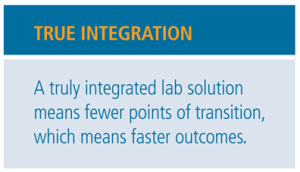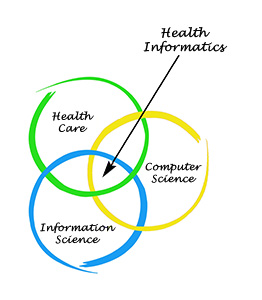Healthcare at its most efficient is a wonderful thing. Rapid, accurate diagnosis followed by effective, targeted treatment can make a huge difference – both in outcomes and patient satisfaction.
Such outcomes, however, rely heavily on clinician access to comprehensive data – including genomic, metabolic and clinical chemistry results.
In many cases, the ‘perfect storm’ of people, technology and processes of healthcare fails to occur. What happens then? Lab results are:
- Not detailed enough.
- Missing key data.
- Unclear or ambiguous.
In some cases, labs don’t actually lack the right data. The lab simply has difficulty capturing, centralizing and sharing it in order to provide clinicians with the right path forward.
The result? Many clinical labs and hospitals find themselves under tremendous pressure to meet clinician and patient needs.
We recently published a white paper which addresses the convergence of increasingly complex healthcare needs, more stringent compliance criteria and an overwhelming quantity of data from numerous, disconnected sources.
 Make Do or Migrate to a LIS?
Make Do or Migrate to a LIS?
In spite of these challenges, some hospitals and labs have adopted a ‘make do’ approach rather than migrate to a more compliant, efficient and effective Laboratory Information System (LIS). The debate over whether to ‘make do’ or migrate, however, is often based on several outdated assumptions or myths.
Here are 5 of the most common myths about your healthcare lab’s LIS.
 ”We already have an integrated LIS.”
”We already have an integrated LIS.”
But do you really? Yes, integration means different things to different people. If your pathology system is connected to a core diagnostic LIS which in turn feeds an interface engine, it may appear seamlessness. But it’s a far cry from the true integration found in a single platform, using a single interface, built on a common architecture, centralizing data from multiple disciplines.

An integrated LIS uses fewer points of transition as data moves smoothly and automatically along a straight and uninterrupted line to deliver faster outcomes. Your LIS should integrate core lab, microbiology, pathology and genetics labs in a common, automation-driven platform.
“Making do hurts less than switching to something new.”
This is the ‘pain’ excuse. But how painful is your status quo? Sure, you’re used to it, but interrupting workflows to troubleshoot IT issues, recovering lost passwords for yet another interface, scanning handwritten reports dictated from another discipline – each of these complications (and others) can lead to delays in diagnosis and treatment. Nonetheless, the perception of a ‘road too steep to climb’ can leave your lab in a state of suspended animation.

Change may be uncomfortable, but with the right solutions team your discomfort is only momentary. More importantly, making the switch to an integrated LIS purpose-built for multidisciplinary healthcare labs means you’ll no longer need to manually translate between interfaces. You’ll reduce lost productivity, gain scalability, and achieve consistent harmonization between lab instruments, systems, and external sources.
“A new LIS will mean new hardware costs.”
Expensive on-premise hardware installations may be outdated, but they aren’t exactly old news. In fact, for some organizations they remain the go-to option even today. But hiding behind the concern of hardware costs to avoid upgrading a LIS, however…well, that’s an obsolete mindset.
 Modern LIS providers offer 100% web-based, cloud-ready solutions that are deeply configurable and require no hardware spending. Gone are the high maintenance fees, lengthy upgrade periods and awkward VPN setups for remote workers. A modern LIS can reduce your overall IT spending by hosting your solution on a scalable, configurable, and secure cloud-based server.
Modern LIS providers offer 100% web-based, cloud-ready solutions that are deeply configurable and require no hardware spending. Gone are the high maintenance fees, lengthy upgrade periods and awkward VPN setups for remote workers. A modern LIS can reduce your overall IT spending by hosting your solution on a scalable, configurable, and secure cloud-based server.
“We don’t have the IT staff to handle implementation.”
Implementing a LIS has historically been an involved process, leaving internal IT teams hamstrung as they try to put complex new software into operation with minimal impact.
 Times have changed, and the best LIS providers today are better positioned to migrate legacy data smoothly and accurately from old systems to new ones. If you have the right service partner, you won’t need a massive internal IT team to have a smooth and rapid implementation and data migration experience.
Times have changed, and the best LIS providers today are better positioned to migrate legacy data smoothly and accurately from old systems to new ones. If you have the right service partner, you won’t need a massive internal IT team to have a smooth and rapid implementation and data migration experience.
“We’ll outgrow a new LIS in five years. Why switch now?”
The traditional approach to software has been to lock into a certain size – whether ‘small business’ or enterprise-level’ – based on an organization’s need. This often led to uncertainties – ‘What happens when we grow?’ ‘Shouldn’t we wait to switch until we’re bigger, to avoid doing this twice?’
 The idea that an organization can outgrow a LIS and force a migration is largely no longer true – especially with cloud-based systems. Today’s LIS can be both fully integrated in your workflow and dynamic & scalable – allowing you to add licenses when needed, automatically updating regulatory standards when they change, introducing new functionality, and more. If you choose a LIS solution that offers integration and scalability, it’s the last switch you’ll ever have to make.
The idea that an organization can outgrow a LIS and force a migration is largely no longer true – especially with cloud-based systems. Today’s LIS can be both fully integrated in your workflow and dynamic & scalable – allowing you to add licenses when needed, automatically updating regulatory standards when they change, introducing new functionality, and more. If you choose a LIS solution that offers integration and scalability, it’s the last switch you’ll ever have to make.

Separate Fact from Fiction
The prospect of migrating to a new LIS can seem daunting, but with the right team of specialists overseeing your move to the right system, it doesn’t need to be. And choosing to make that move now, rather than waiting until your lab operations are so complex that migration is mission-critical, means you’ll have greater control over the process and a clearer path through its complexities.
Check out the LabVantage whitepaper: Five Myths That Drain Time and Money From Your Healthcare Lab.
Want to learn how switching to a truly integrated LIS could transform your lab’s efficiency?
Visit > https://www.labvantage.com//your-lab-type/medical-lis/



